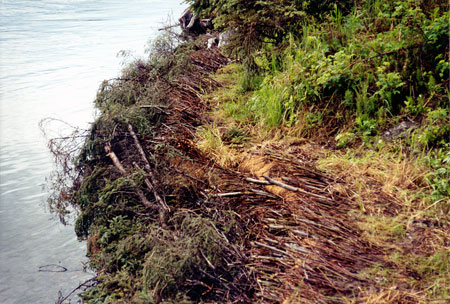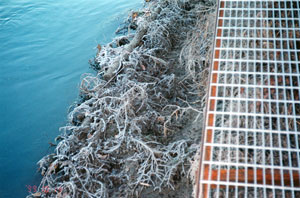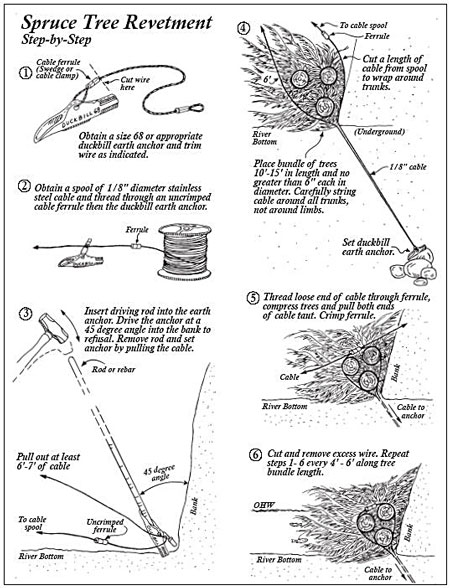Streambank Revegetation and Protection: A Guide for Alaska
Protection Techniques: Spruce Tree Revetments
Spruce tree revetments protect streambanks from erosion and provide increased bank protection. This is a relatively inexpensive and functional bank protection technique. Spruce tree revetments trap sediment, and over time, aid in rebuilding bank structure and establishing long-term bank stability. The tree limbs reduce near-bank water velocities, provide protection from scour and erosion, provide cover for juvenile fish, and act as a source of organic debris.

Spruce tree revetments are often used in combination with revegetation techniques. They provide immediate cover for fish until living plant cover is provided by the revegetation techniques. Consultation with a streambank revegetation specialist is necessary to determine site needs and revetment design. Spruce tree revetments may involve a single layer of spruce trees, multiple spruce trees cabled together, or single layers stacked. All revetments require an adequate cable and anchoring system. Selected spruce trees should be green and limber with many branches. When collecting, be careful not to damage surrounding vegetation when harvesting and transporting spruce trees. Anchor spruce tree revetment into well-vegetated and non-sloughing banks at both upstream and downstream ends.
Install 4-6 inch diameter spruce trees parallel to the streambank and overlap 1/3 to 1/2 of their length in a shingle fashion. The top of the tree should be orientated downstream. Care should be taken to avoid unnecessary damage to, or removal of, tree limbs. The trees are secured tightly to the bank with 1/8-inch cable and earth anchors every 4-6 feet. In higher velocity systems, 3/16 cable and larger and more frequent earth anchors may be used.

Maintain spruce tree revetments by adding new trees every 1-3 year(s). Fresh, bushy trees may be cabled directly in front of the original revetment. Spruce trees must be anchored securely and checked yearly to replace cable and add new trees. Remove excess cable and retighten any loose cable around trees. If the trees are not maintained and the trees deteriorate over time, any visible cables or anchors should be removed from below ordinary high water.
Advantages:
- Easily installed, no heavy equipment needed
- Materials readily available
- Inexpensive
- Provides soil erosion protection and fish habitat
- Least intrusive of bank protection techniques
Disadvantages:
- Maintenance required every 1-3 year(s)
- Must remove excess cable/visable anchors and add new trees as necessary
Step-by-Step Guide (PDF 1,155 kB)

